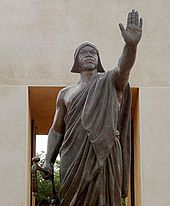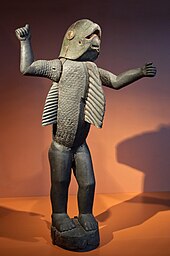Béhanzin
This article needs additional citations for verification. (April 2021) |
| Béhanzin | |
|---|---|
| King of Dahomey | |
 King Béhanzin, c. 1895 | |
| Reign | c. January 1890 – c. 1894 |
| Predecessor | Glele |
| Successor | Agoli-agbo |
| Born | c. 1845 |
| Died | December 10, 1906 (aged 60–61) Algiers, French Algeria |
| Father | Glele |


Béhanzin (c. 1845 – 10 December 1906) is considered the eleventh (if Adandozan is not counted) King of Dahomey, modern-day Republic of Benin.[1] Upon taking the throne, he changed his name from Kondo.
Biography[]
This section may be too long to read and navigate comfortably. (December 2019) |
He succeeded his father, Glele, and ruled from 1889 to 1894. Béhanzin was Dahomey's last independent ruler established through traditional power structures. He led the resistance to French colonization of his kingdom, during the Dahomey Wars.
Each of Dahomey's kings was represented in sculpture with images that referred to the proverbs, associations, and wordplay attached to his royal name.[2] The images that symbolize Behanzin (or Gbehanzin) include an egg held by a hand, as the words for these in the Fon language form a rebus, or pun, of the royal name. As may be seen in the large wooden statue once displayed in the royal palace at Abomey (and now in the Musee Quai Branly in Paris), the shark is a metaphor for Behanzin; as does the shark, the king guards the coast of the kingdom of Dahomey. A captive hanging from a flagpole is a reference to a man from the Nago, or Yoruba, city of Ketou, a powerful rival state. This prisoner had boasted that he could attack the king with magic, but Behanzin hanged him from a flagpole as punishment for his rebellion. The king's most famous symbol is the smoking pipe. This is because he claimed that there wasn't a minute in his life, even when he was a baby, that he was not smoking tobacco.
{According to??] Béhanzin was seen by his people as intelligent and courageous. He saw that the Europeans were gradually encroaching on this section of the West African Coast, and as a result attempted a foreign policy of isolating the Europeans and rebuffing them. As prince just before the death of his father Glele, Béhanzin declined to meet French envoy Jean Bayol, claiming conflicts in his schedule due to ritual and ceremonial obligations. As a result, Bayol returned to Cotonou to prepare to go to war against Béhanzin, named king upon Glele's death. Seeing the preparations, the Dahomeans attacked Bayol's forces outside Cotonou in 1890; the French army stood fast due to superior weaponry and a strategically advantageous position. Eventually Béhanzin's forces were forced to withdraw. Béhanzin returned to Abomey, Bayol to France for a time.
The peace lasted two years, during which time the French continued to occupy Cotonou. Both sides continued to buy arms in preparation for another battle. In 1892, the soldiers of Abomey attacked villages near Grand Popo and Porto-Novo in an effort to reassert the older boundaries of Dahomey. This was seen as an act of war by the French, who claimed interests in both areas. , by now named Colonial Governor by the French, declared war on Béhanzin. The French war machine justified the aggression by characterizing the Dahomeans as savages in need of civilizing, and pointing to the human sacrifice made to the royal ancestors at the annual ceremonies known as annual customs and at a king's death, as evidence of this savagery. The French also pointed to existence of the women's militia that protected the king,[3] whom the Fon referred to simply as Minon (or "mothers), but the French called Amazons after the fierce women warriors of Greek mythology.
Some official French propaganda from the period may be seen in prints depicting these so-called Amazons. One source [citation needed] claims that in one of the battles an Amazon killed a French officer by ripping out his throat with her sharpened teeth. Parallel accounts of the event handed down in Benin describe the Amazon as a trusted wife of Béhanzin who had sworn to avenge members of the royal family who had been executed by Béhanzin for treachery after divulging battle plans in return for bribes from French agents. The French officer she is said to have killed was allegedly the head of French military intelligence who committed the 'savage' act of corrupting family members to betray their own; the Amazon was reduced to using her teeth after her ammunition ran out at the battle's peak.
Through superior intelligence gathering, superior weaponry, bribery, a campaign of psychological warfare that included cutting down most of the sacred trees in the Oueme and Zou, and an unexpected strategy, the French succeeded in defeating Dahomey, one of the last African kingdoms to succumb to European colonization. Instead of attacking Abomey directly by marching straight north from just north of Cotonou, French General Alfred Dodds attacked from Porto-Novo, moving up the Oueme valley until he was within striking distance of Abomey, via Cove and Bohicon.
The French were victorious, and in 1894, Béhanzin surrendered his person to Dodds, without signing any instrument of national surrender or treaty. He lived out the remainder of his life in exile in Martinique and Algeria. After his death, his remains were returned to Abomey. His throne, his sculptures of wood, copper, iron and silver are now in the Musee Quai Branly, and have been the topic of important discussions about their return to the Republic of Benin.[4]
Béhanzin was succeeded by Agoli-agbo, his distant relative and one-time Army Chief of Staff, the only potential ruler with whom the French were willing to negotiate.
Symbols[]

Royal banner

Coat of arms
References[]
- ^ http://www.wdl.org/en/item/269/
- ^ Blier, Suzanne (1990). "King Glele of Danhome". African Arts. 23 (4): 42–53, 93–4. doi:10.2307/3336943. JSTOR 3336943.
- ^ Alperin, Stanley (1998). "On the Origins of the Amazons". History in Africa. 25: 9–25. doi:10.2307/3172178. JSTOR 3172178.
- ^ Hickley, Catherine. "France takes first legal step towards restitutions to Beninds". The Art Newspaper. The Art Newspaper International. Retrieved 3 September 2020.
See also[]
| Wikimedia Commons has media related to Behanzin. |
- Kings of Dahomey
- 1844 births
- 1906 deaths
- 19th-century monarchs in Africa
- 19th century in Dahomey
- French Third Republic
- People of French West Africa

